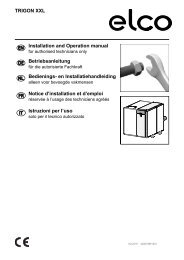Nimbus Compact M NET R32 Installation Manual UK
You also want an ePaper? Increase the reach of your titles
YUMPU automatically turns print PDFs into web optimized ePapers that Google loves.
7. Service<br />
Maintenance is an essential operation to ensure safety, correct<br />
heat pump operation and long-lasting life of the system.<br />
It must be carried out in accordance with applicable regulations.<br />
i<br />
i<br />
i<br />
The manufacturer’s maintenance and assistance<br />
guidelines must be observed at all times. In case<br />
of doubts, contact the Technical Assistance Centre.<br />
Work shall be undertaken under a controlled<br />
procedure so as to minimise the risk of a flammable<br />
gas or vapour being present while the work is<br />
being performed.<br />
All maintenance staff and others working in the<br />
local area shall be instructed on the nature of<br />
work being carried out. Work in confined spaces<br />
shall be avoided.<br />
It is necessary to verify the refrigerant gas pressure during annual<br />
maintenance operations.<br />
Before beginning maintenance work:<br />
– Disconnect the power supply to the system.<br />
– If they are present, close the water taps of the space<br />
heating and domestic hot water circuits.<br />
Repair and maintenance to electrical components shall include<br />
initial safety checks and component inspection procedures.<br />
If a fault exists that could compromise safety, then no electrical<br />
supply shall be connected to the circuit until it is satisfactorily<br />
dealt with. If the fault cannot be corrected immediately but it is<br />
necessary to continue operation, an adequate temporary solution<br />
shall be used. This shall be reported to the owner of the<br />
equipment so all parties are advised.<br />
Initial safety checks:<br />
– check that the capacitors are empty; this must be done<br />
safely to prevent possible sparks; wait at least 10 minutes<br />
for the capacitor to discharge before performing<br />
further interventions;<br />
– check that no live component and electrical wiring are<br />
exposed during charging, recovery or purging of the<br />
system;<br />
– check that the earthing connection is uninterrupted.<br />
a<br />
a<br />
Ensure that the area is in the open or that it is<br />
adequately ventilated before breaking into the<br />
system or conducting any hot work.<br />
If any work must be carried out on hot cooling<br />
equipment or on any other associated part, adequate<br />
fire-safety equipment must be on hand.<br />
Keep a dry powder or CO2 fire extinguisher close<br />
to the charging area.<br />
a<br />
a<br />
a<br />
a<br />
a<br />
a<br />
a<br />
a<br />
a<br />
Service<br />
The ventilation should safely disperse the refrigerant<br />
released and preferably expel it towards<br />
the outside.<br />
A degree of ventilation shall continue during the<br />
period that the work is carried out.<br />
The repair and maintenance of electrical components<br />
should include initial safety checks and<br />
component inspection procedures.<br />
Where electrical components are being changed,<br />
they shall be fit for the purpose and to the correct<br />
specification.<br />
If there is a fault that could jeopardise safety, do<br />
not connect the power supply to the circuit until<br />
the problem has been adequately resolved.<br />
If the fault cannot be resolved immediately but<br />
the device must nonetheless continue operating,<br />
adopt an adequate temporary solution. This<br />
must be signalled to the owner of the equipment<br />
so that all relevant parties can be notified.<br />
During repairs to sealed components, all electrical<br />
supplies shall be disconnected from the<br />
equipment being worked upon prior to any removal<br />
of sealed covers, etc. If it is absolutely necessary<br />
to have an electrical supply to equipment<br />
during servicing, then a permanently operating<br />
form of leak detection shall be located at the<br />
most critical point to warn of a potentially hazardous<br />
situation.<br />
The area shall be checked with an appropriate<br />
refrigerant detector prior to and during work,<br />
to ensure the technician is aware of potentially<br />
toxic or flammable atmospheres. Ensure that the<br />
leak detection equipment being used is suitable<br />
for use with all applicable refrigerants, i.e.<br />
non-sparking, adequately sealed or intrinsically<br />
safe.<br />
Particular attention shall be paid to the following<br />
to ensure that by working on electrical components,<br />
the casing is not altered in such a way<br />
that the level of protection is affected. This shall<br />
include damage to cables, excessive number<br />
of connections, terminals not made to original<br />
specification, damage to seals, incorrect fitting<br />
of glands, etc.<br />
Ensure that seals or sealing materials have not<br />
degraded to the point that they no longer serve<br />
the purpose of preventing the ingress of flammable<br />
atmospheres.<br />
70 / EN

















